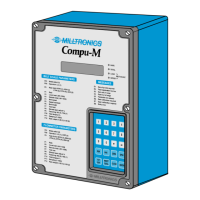APPLICATIONS
BELT SCALE APPLICATION
OPERATION
Input Signals
The Compu-M supplies the excitation for the belt scale load cell(s). The load cell(s) produce an analog mV
signal which is proportional to the load on the scale.
Excitation is also provided for a speed sensor. If used, the speed sensor produces a digital signal at a
frequency which is proportional to belt speed.
In cases where a speed sensor is not used, the Compu-M simulates a speed sensor input representing a
constant belt speed which is operator adjustable to suit the particular application.
If the Compu-M is to be utilized with a belt scale that is installed on a variable incline conveyor (such as a
stacker), an Incline Compensator should be used. The Incline Compensator automatically corrects the load
cell(s) signal variation caused by a change in conveyor incline.
Signal Processing
The Compu-M utilizes the load and speed signals to produce an internal rate signal. Utilizing advanced
microprocessor technology the Compu-M converts the internal rate signal to provide; display, analog output,
remote totalizer contact and rate alarm.
Display Modes
Four operator selectable display modes are available (RATE, TOTAL, LOAD or SPEED ). The modes can be
scrolled manually by pressing ‘ALT DISP’, or the Rate and Total automatically by setting P21, auto scroll display.
The Rate, Load, Speed displays, in operator selectable engineering units, are stabilized by the level of damping
programmed (P11).
The Rate Display represents the rate at which material is currently conveyed.
The Total Display represents the total amount of material which has passed over the belt scale since the last
Compu-M (local) totalizer reset. The operator may reset this display to zero (0) at any time, depending on the
access security level programmed, by pressing
"RESET TOTAL", "CLEAR"
.
The Load Display represents the force currently applied to the belt scale by the weight of the material on the belt.
The Speed Display represents the current belt speed.
PL-516 27

